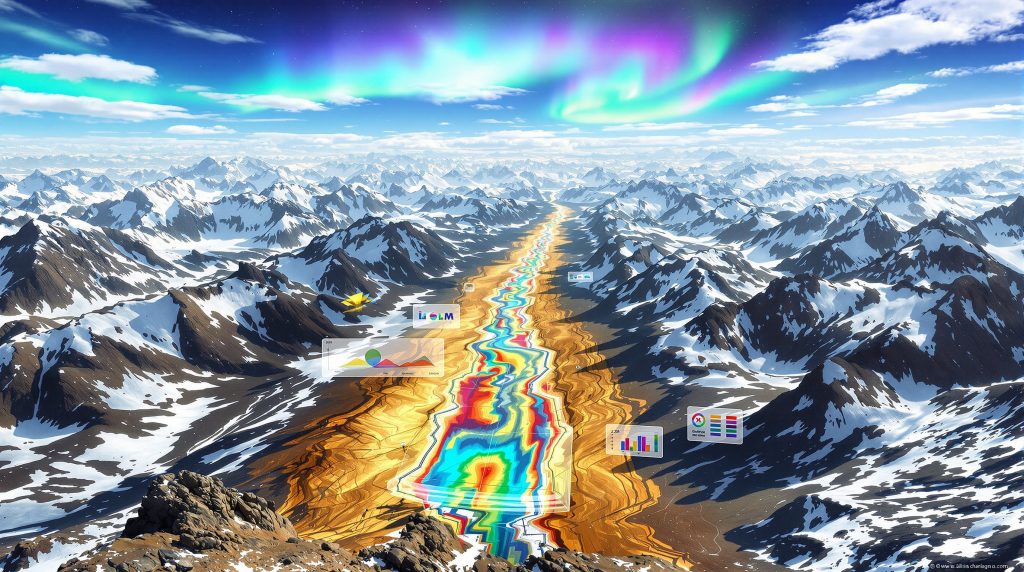Understanding North America's Longest Strike-Slip Fault Network
The Tintina Rocky Mountain Trench fault represents one of North America's most extensive continental fault systems, stretching across multiple geological provinces and demonstrating the profound influence of plate tectonics on continental architecture. This massive fault network has fundamentally shaped the landscape from Alaska to Montana, creating distinctive linear valleys and accommodating hundreds of kilometers of crustal displacement over geological time. Furthermore, the mineral exploration importance of this region has been significantly enhanced by the structural controls provided by this fault system.
Geographic Extent and Structural Complexity
The fault system encompasses two primary segments with distinct characteristics and orientations. The Tintina Fault extends approximately 1,100-1,200 kilometers through Alaska and Yukon Territory, displaying predominantly right-lateral strike-slip motion that reflects ongoing Pacific-North American plate interactions. The Rocky Mountain Trench continues southward for roughly 900-1,000 kilometers from northern British Columbia into Montana, exhibiting more complex kinematics that include both extensional and strike-slip components.
| Fault Component | Length | Primary Motion | Key Features |
|---|---|---|---|
| Tintina Fault | 1,100-1,200 km | Right-lateral strike-slip | Linear valleys, gold districts |
| Rocky Mountain Trench | 900-1,000 km | Mixed extensional/strike-slip | Lake systems, transportation corridors |
| Combined System | ~2,000+ km | Variable | Continental-scale deformation zone |
The system demonstrates cumulative horizontal displacement estimates ranging from 200 to over 450 kilometers, though these figures vary significantly depending on the reference points and measurement methodologies employed. This displacement represents one of the largest documented offsets along any continental fault system, rivaling the cumulative motion observed along California's San Andreas Fault system.
Structural Components and Regional Connections
The northern Tintina Fault segment connects northwestward to Alaska's Kaltag Fault system and integrates with the broader Denali Fault network through complex structural transitional zones. These connections demonstrate how major continental fault systems interact and transfer strain across vast distances, creating interconnected networks that accommodate regional plate motions.
The southern Rocky Mountain Trench segment displays fundamentally different structural characteristics, with extensional normal faulting becoming increasingly prominent southward. This transition reflects changing stress fields and the integration of Basin and Range-style extension with strike-slip tectonics, creating a complex zone of distributed deformation.
How Did the Tintina Rocky Mountain Trench Form?
The formation of this continental-scale fault system reflects the complex interplay between Pacific and North American plate interactions spanning the past 70-100 million years. Understanding these processes requires examining both the regional tectonic context and the specific mechanisms that drove fault initiation and evolution.
Tectonic Forces and Plate Boundary Evolution
The fault system's development parallels the broader evolution of western North American tectonics, where Pacific Plate motion toward the northwest intersects with North American Plate movement toward the west and southwest. This oblique convergence creates both compressive and strike-slip stress fields that become localized along major fault zones. Additionally, supercontinent cycles insights help explain the broader geological context of this fault formation.
The Pacific plates have progressively captured sectors of the North American plate and transformed them northward since at least 70 million years ago, fundamentally reshaping continental architecture through this ongoing tectonic process.
Timeline of Geological Development
Late Cretaceous Initiation (70-80 million years ago):
- Major strike-slip activity begins during changing subduction geometry
- Initial fault development reflects Pacific-North American plate reorganization
- Regional stress field changes drive fault localization and growth
Paleocene-Eocene Evolution (60-40 million years ago):
- Fault system reactivation and geometric refinement
- Integration with broader Cordilleran fault networks
- Accommodation of changing plate motion vectors
Cenozoic Continuation (40 million years ago-present):
- Ongoing displacement accumulation and fault refinement
- Quaternary modifications through glacial-interglacial cycles
- Modern stress accumulation and seismic activity patterns
Strike-Slip Mechanics and Displacement Processes
The right-lateral strike-slip motion characteristic of the Tintina Fault reflects the relative motion between Pacific and North American plates. As these plates interact along their boundary, the Pacific Plate's northwestward motion creates shear stress that becomes accommodated through horizontal displacement along optimally oriented fault planes.
Modern GPS measurements from networks operated by UNAVCO and Canadian geodetic agencies document ongoing strain accumulation across the fault system, though displacement rates vary significantly along different segments. Some areas show measurable annual motion while others display minimal interseismic deformation, reflecting the complex nature of fault loading and stress distribution.
What Makes This Fault System Geologically Significant?
The geological significance of the Tintina Rocky Mountain Trench fault extends far beyond its impressive dimensions, encompassing its role in continental tectonics, mineral resource distribution, and long-term landscape evolution.
Displacement Magnitude and Geological Evidence
Multiple lines of geological evidence document the fault system's extraordinary displacement history:
- Offset stratigraphic formations across fault zones show measurable lateral displacement
- Disrupted drainage patterns where rivers and streams display deflection and offset
- Separated mineral districts with gold deposits on opposite fault sides showing post-mineralization offset
- Misaligned mountain segments where structural trends show clear geometric disruption
The Klondike gold district and related mineralization along the Tintina Fault corridor provide particularly compelling evidence of fault-controlled geology. These deposits show structural control by the fault system, with mineralization patterns reflecting fault-enhanced permeability and hydrothermal fluid flow during active deformation periods. Consequently, understanding mineral deposit tiers becomes crucial when evaluating these fault-controlled ore bodies.
Continental-Scale Deformation Accommodation
The fault system serves as a fundamental component of western North American tectonics, accommodating strain that would otherwise be distributed across much broader regions. This localization of deformation creates distinct geological provinces and controls the distribution of seismic hazards, mineral resources, and topographic features across multiple states and provinces.
Cumulative displacement estimates of 200-450+ kilometers developed over 70-100 million years yield implied average displacement rates of 2-6.5 millimeters per year. These rates, calculated from total displacement divided by time duration, provide context for understanding the fault's long-term behavior and comparison with other major continental fault systems.
Where Does the Fault System Create Notable Topographic Features?
The Tintina Rocky Mountain Trench fault has carved distinctive landscape features that define much of the regional topography from Alaska to Montana. These fault-controlled valleys represent some of North America's most prominent linear topographic features.
The Tintina Trench Landscape
The Tintina Trench displays remarkably consistent linear valley geometry extending through Alaska and Yukon Territory. This valley system creates natural corridors that have influenced both wildlife migration patterns and human transportation infrastructure throughout history.
Key characteristics include:
- Consistent valley orientation following fault trace geometry
- Relief ranging from 1,000-2,000 meters from valley floor to surrounding mountains
- Integration with major river systems and glacial-tectonic lakes
- Historical significance as travel and trading corridors
Rocky Mountain Trench Valley System
The southern portion of the fault system creates the prominent Rocky Mountain Trench, a continuous valley feature with varying characteristics along its length:
| Trench Segment | Characteristics | Width Range | Dominant Features |
|---|---|---|---|
| Northern BC | Strike-slip valleys | 2-8 km | Linear drainage integration |
| Central BC | Mixed fault mechanics | 5-15 km | Lake systems, broad valleys |
| Southern BC/Montana | Normal fault valleys | 3-12 km | Extensional basins |
Human Geography and Infrastructure Development
The linear valley geometry created by fault activity has profoundly influenced human settlement patterns and infrastructure development. Major transportation corridors, including highways and railways, align with these fault-controlled valleys, taking advantage of the natural low-relief routes through otherwise mountainous terrain.
Modern infrastructure alignment includes:
- Trans-Canada Highway segments following trench geometry
- Railway routes utilizing fault-controlled passes
- Settlement patterns concentrated in valley floors
- Resource extraction accessibility enhanced by fault-controlled topography
Is the Tintina Rocky Mountain Trench Fault Still Active?
The question of ongoing activity along the Tintina Rocky Mountain Trench fault carries significant implications for regional seismic hazard assessment and understanding of contemporary tectonics in northwestern North America.
Current Seismic Activity Documentation
Seismic monitoring networks operated by the Alaska Earthquake Center, Natural Resources Canada, and regional universities document ongoing earthquake activity along various segments of the fault system. Current seismic catalogs reveal:
- Regular earthquake occurrence with magnitudes typically ranging from 2.0 to 5.5
- Average magnitude range of 2-4 for most recorded events
- Multiple seismic events documented annually along different fault segments
- Periodic larger events (M5+) demonstrating continued capacity for significant energy release
While the fault system currently produces mostly moderate earthquakes in the magnitude 3-4 range, geological evidence suggests it remains capable of generating much larger seismic events based on its structural characteristics and displacement history.
Evidence of Quaternary Activity
Paleoseismic investigations provide crucial evidence for recent fault activity through direct observation of geological offset. These studies document:
- Quaternary fault scarps preserved in unconsolidated sediments
- Offset glacial deposits with radiometric age constraints
- Disrupted tephra layers (volcanic ash) showing fault displacement timing
- Stream terrace offsets indicating recent surface rupture events
Trench excavations across fault zones have exposed clear evidence of ground ruptures affecting materials deposited within the past 2.6 million years (Quaternary Period), confirming that the fault system remains capable of producing surface-rupturing earthquakes. Moreover, drill results interpretation from exploration programs along the fault corridor often reveals recent fault activity through offset geological markers.
Modern Geodetic Monitoring
Continuous GPS networks maintained by UNAVCO and Canadian geodetic agencies provide real-time measurements of crustal deformation across the fault system. Preliminary analysis of this data suggests:
- Variable strain rates along different fault segments
- Measurable annual displacement in some monitoring locations
- Minimal interseismic motion in other areas
- Complex strain distribution reflecting fault system geometry and loading patterns
How Does This Compare to Other Major Fault Systems?
Placing the Tintina Rocky Mountain Trench fault in global context reveals both similarities and distinctive characteristics compared to other major continental strike-slip systems worldwide.
San Andreas Fault System Parallels
The San Andreas Fault provides the most direct comparison for understanding Tintina fault mechanics. Both systems accommodate Pacific-North American plate boundary motion through right-lateral strike-slip displacement, though they operate in different geological settings.
Key similarities include:
- Right-lateral strike-slip motion accommodating plate boundary deformation
- Segmented fault geometry with varying displacement rates
- Integration with broader fault networks and secondary structures
- Long-term displacement accumulation over millions of years
Significant differences:
- San Andreas system: Currently more seismically active with documented slip rates of 20-35 mm/year
- Tintina system: Lower current seismic activity with uncertain modern slip rates
- Geological setting: San Andreas operates in active transform boundary; Tintina represents intraplate deformation
- Displacement history: Different timing and duration of major activity periods
Global Strike-Slip Fault Context
| Fault System | Location | Length | Max Displacement | Primary Characteristics |
|---|---|---|---|---|
| Tintina-Rocky Mountain Trench | North America | ~2,000 km | 200-450+ km | Continental intraplate system |
| Dead Sea Transform | Middle East | ~1,000 km | ~105 km | Active plate boundary |
| Alpine Fault | New Zealand | ~600 km | ~480 km | Transform plate boundary |
| North Anatolian Fault | Turkey | ~1,500 km | ~85 km | Active continental transform |
| Altyn Tagh Fault | Central Asia | ~2,000 km | ~400+ km | Intracontinental strike-slip |
Unique Characteristics and Global Significance
The Tintina Rocky Mountain Trench fault demonstrates several distinctive features that set it apart from other major fault systems:
Length-to-displacement ratios that indicate efficient strain accommodation over geological time, with displacement magnitudes comparable to much shorter, more active systems. This suggests either higher historical activity rates or longer duration of activity than currently recognized.
Multi-segment complexity involving both strike-slip and extensional components creates unusual fault mechanics not commonly observed in other major continental systems. This transitional behavior reflects the complex stress field environment of western North America. However, recent research has provided new insights into the Tintina fault system, suggesting it may be more active than previously understood.
Preservation of geological record along the fault system provides exceptional opportunities for studying long-term fault behavior and continental tectonics, with geological markers preserving evidence of displacement over tens of millions of years.
What Role Does the Fault Play in Regional Mineral Resources?
The Tintina Rocky Mountain Trench fault has profoundly influenced mineral resource distribution across northwestern North America, creating structural conditions that control both the formation and preservation of economically significant deposits.
Structural Control on Mineralization Processes
Fault-related hydrothermal systems developed along the Tintina corridor have created some of North America's most significant gold mining districts. The fault's geometry and kinematics create zones of enhanced permeability that facilitate fluid flow and mineral precipitation. In addition, mineralogy and economics play crucial roles in determining the viability of these fault-controlled deposits.
Key mineralizing processes include:
- Enhanced fracture permeability allowing hydrothermal fluid circulation
- Structural preparation creating favorable host rock conditions
- Fluid focusing mechanisms concentrating mineralizing solutions
- Repeated reactivation enabling multiple mineralization episodes
Gold Districts and Economic Geology
The Klondike gold district represents the most famous example of Tintina fault-related mineralization, though numerous other deposits occur along the fault corridor. These districts demonstrate clear structural control by fault-related features:
- Dawson City area showing fault-controlled placer and lode gold deposits
- Mayo district with fault-related silver-lead-zinc mineralization
- Watson Lake region displaying diverse base and precious metal occurrences
- Fairbanks district in Alaska showing similar fault-controlled gold systems
Modern exploration strategies increasingly recognise the Tintina fault corridor as a metallogenic province where structural geology controls resource distribution. This recognition has led to focused exploration programs targeting fault-related mineralization along the entire system length.
Resource Accessibility and Development
The linear valley topography created by fault activity provides enhanced accessibility for resource development, reducing infrastructure costs and environmental impacts compared to deposits in more rugged terrain. This accessibility has historically influenced mining development patterns and continues to affect modern resource evaluation.
How Do Scientists Study This Massive Fault System?
Investigating a continental-scale fault system like the Tintina Rocky Mountain Trench fault requires diverse scientific approaches and sophisticated technological tools to understand its complex behavior across multiple time scales.
Modern Research Methodologies
Contemporary fault studies employ multiple complementary techniques to build comprehensive understanding:
- Satellite geodesy and GPS networks providing millimeter-precision measurements of crustal motion
- Paleoseismic trench excavations revealing earthquake timing and displacement history
- Geophysical imaging techniques including seismic reflection and gravity surveys
- Geochronological dating methods constraining timing of fault activity and displacement events
- LiDAR topographic mapping revealing subtle fault scarps and surface deformation
- InSAR satellite monitoring detecting ground motion with centimeter-level precision
Technological Advances in Fault Investigation
Machine learning applications increasingly assist in earthquake pattern recognition and hazard assessment, processing vast datasets from seismic networks to identify subtle patterns in fault behavior. These computational approaches complement traditional geological field methods with data-driven insights.
Seismic tomography provides three-dimensional images of subsurface structure, revealing fault geometry and its relationship to regional tectonics. This technique helps scientists understand how the Tintina system connects with other major fault networks and accommodates regional strain.
Ongoing Research Questions and Challenges
Critical research priorities focus on several key uncertainties:
- Slip rate variations along different fault segments and their implications for seismic hazard
- Earthquake recurrence intervals based on paleoseismic evidence and statistical analysis
- Fault interaction mechanisms determining how different segments influence each other
- Climate change effects on fault stability and earthquake triggering processes
Interdisciplinary collaboration between geologists, seismologists, geodesists, and geophysicists continues expanding understanding of fault system behavior. These collaborative approaches integrate field observations, laboratory experiments, and numerical modeling to address complex questions about continental tectonics.
What Are the Implications for Future Geological Hazards?
Understanding seismic hazards associated with the Tintina Rocky Mountain Trench fault requires careful assessment of both current activity levels and geological evidence for larger historical events.
Seismic Hazard Assessment by Region
| Region | Current Risk Level | Primary Hazard Factors | Infrastructure Considerations |
|---|---|---|---|
| Alaska segments | Moderate to High | Active seismicity, populated areas | Critical facilities, transportation |
| Yukon Territory | Low to Moderate | Limited population, remote location | Pipeline infrastructure, mining |
| British Columbia | Variable | Segment-dependent activity | Urban centres, transportation corridors |
| Montana | Lower | Different fault mechanics | Agricultural areas, energy infrastructure |
Infrastructure and Development Considerations
Building code implications vary significantly across the fault system's extent, reflecting different national standards and local seismic hazard assessments. However, the potential for large earthquakes along any segment requires careful consideration in long-term planning.
Critical infrastructure vulnerability includes:
- Transportation networks crossing fault zones at multiple locations
- Energy infrastructure including pipelines and transmission lines
- Communication systems potentially affected by fault displacement
- Emergency response capabilities in remote regions along fault trace
Land use planning considerations must account for both direct fault hazards (surface rupture) and secondary effects (landslides, liquefaction) that could affect development along fault-controlled valleys.
Climate Change Interactions and Long-term Factors
Glacial loading and unloading effects may influence fault stress states as climate change alters ice mass distribution across the fault system's northern extent. Historical glacial cycles have potentially affected earthquake timing through stress changes caused by ice sheet weight variations.
Permafrost changes in northern regions could affect ground stability and monitoring infrastructure, while extreme weather events may impact earthquake detection and response capabilities in remote areas along the fault system.
The Tintina Rocky Mountain Trench's Ongoing Geological Story
The Tintina Rocky Mountain Trench fault system represents far more than a static geological feature carved into North America's landscape. It embodies an active, evolving component of continental tectonics that continues shaping the region's geology, topography, and human geography.
Continental-Scale Deformation and Tectonic Significance
This remarkable fault system demonstrates how continental interiors accommodate plate boundary forces through localised deformation zones. The cumulative displacement of 200-450+ kilometers achieved over 70-100 million years illustrates the profound influence of persistent tectonic forces on continental architecture.
The system's dual nature — combining strike-slip and extensional tectonics — provides insights into how complex stress fields create varied fault behaviour along individual systems. This complexity challenges simplified models of fault behaviour and demonstrates the sophisticated responses of continental lithosphere to changing boundary conditions.
Scientific Research Importance and Future Directions
Enhanced monitoring networks incorporating modern geodetic and seismological instruments will provide unprecedented insights into fault system behaviour. The integration of satellite-based monitoring, ground-based GPS networks, and seismographic arrays offers opportunities to observe fault loading and stress redistribution in real-time.
Interdisciplinary collaboration between geological, geophysical, and engineering communities will advance both scientific understanding and practical hazard mitigation strategies. These collaborations are essential for addressing complex questions about fault system evolution and seismic hazard assessment.
Technology integration advances including artificial intelligence applications and high-performance computing will enable more sophisticated analysis of fault behaviour patterns and improved earthquake forecasting capabilities.
The Tintina Rocky Mountain Trench fault system continues revealing new insights about continental tectonics, seismic hazards, and the dynamic nature of Earth's crust. As scientific understanding advances through improved monitoring and research techniques, this continental-scale fault system will undoubtedly continue providing crucial insights into the fundamental processes shaping North America's geological evolution.
Disclaimer: This analysis incorporates current scientific understanding of fault systems based on published geological literature. Seismic hazard assessments and displacement rate estimates may be revised as new research data becomes available. Readers should consult current official hazard assessments from relevant geological survey organisations for location-specific risk evaluations.
Ready to Capitalise on Geological Discoveries?
Discovery Alert's proprietary Discovery IQ model delivers real-time alerts on significant ASX mineral discoveries, instantly empowering subscribers to identify actionable opportunities ahead of the broader market. Understand why major mineral discoveries can lead to substantial market returns by exploring Discovery Alert's dedicated discoveries page, showcasing historic examples of exceptional outcomes, and begin your 30-day free trial today to position yourself ahead of the market.




